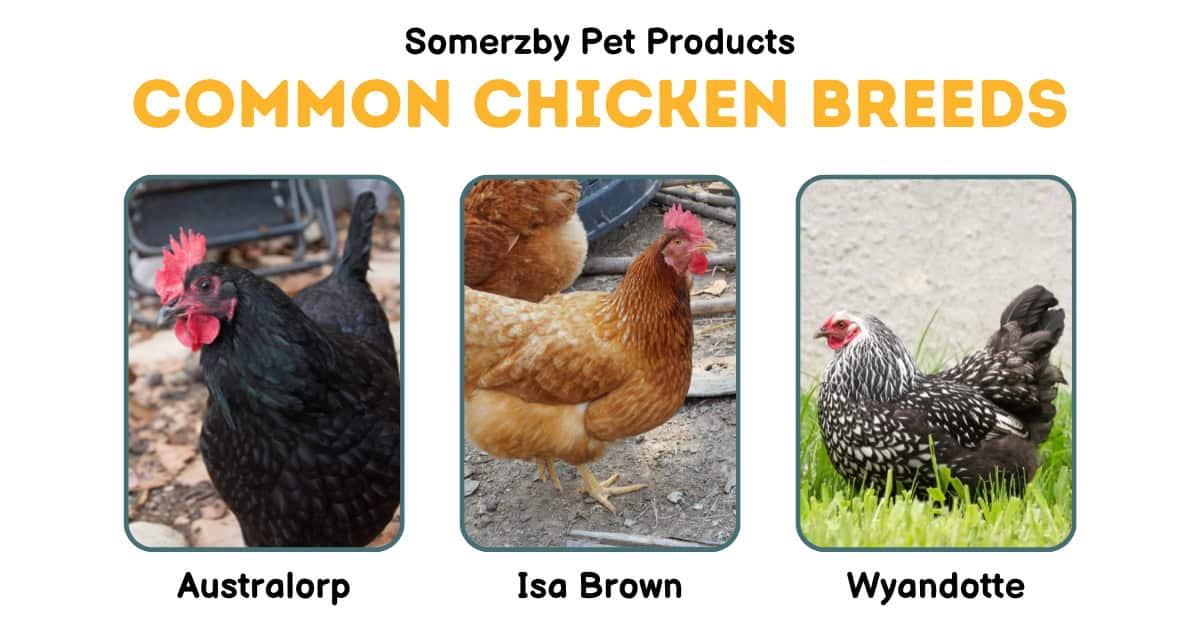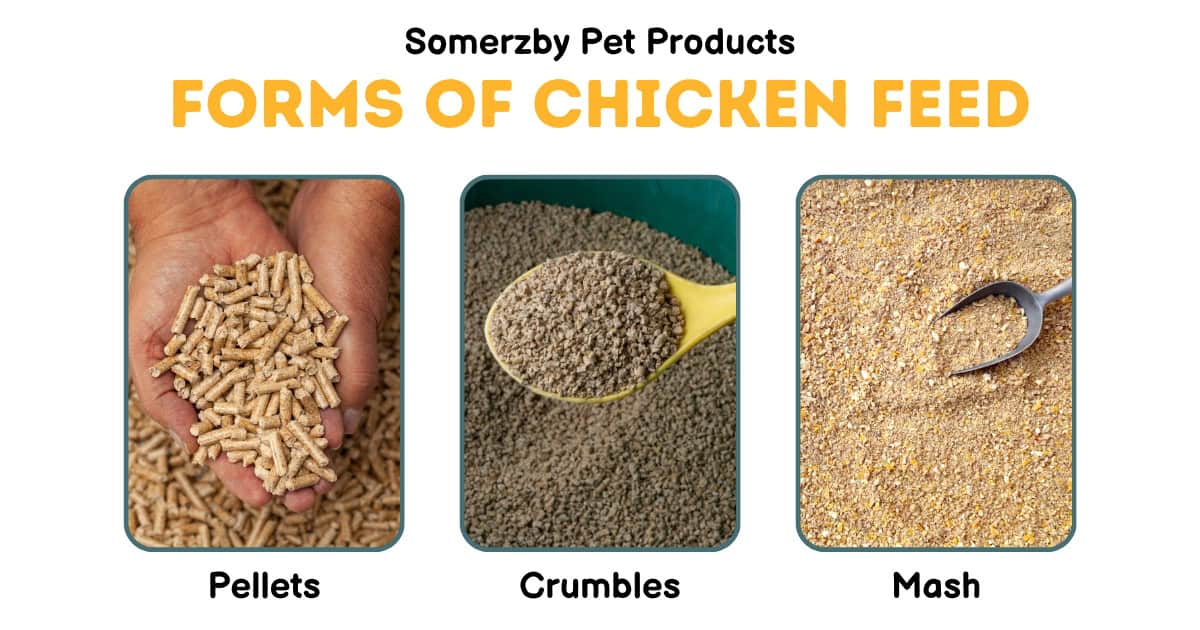Chickens
Ultimate Beginners Guide to Keeping Chickens in Your Backyard
We’ve been selling chicken coops for over 10 years at Somerzby. We also are backyard chicken keepers ourselves and have learnt a lot along the way!
If you’ve heard all the great reasons to keep chickens and have decided to take the plunge, check out our Ultimate Beginners Guide to Keeping Chickens in Your Backyard. Here, we will walk you through everything you need to know about chicken keeping and answer all the common questions that customers ask us every day.
Chicken Coops
If you’re going to buy chickens, the first step is to setup a chicken coop in your backyard.
Although they are reasonably hardy, chickens need to be protected from weather extremes and have a safe and dry place to sleep and nest.
Somerzby have a great range of chicken coops that will provide the perfect solution for your chicken housing.
How Much Space Do You Need Per Chicken?
A very important part of maintaining healthy animals is allowing them to retain their natural behaviours as much as possible.
Our large chicken coops give your chickens the space to be right proper chooks.
Large chook pens or chicken runs allow your chickens to be healthy, happy, carefree chickens.
Size of the Coop
The internal coop space needed can vary depending on the size and number of chickens.
According to Dr. Mikelle Roeder, nutritionist for Purina Animal Nutrition, “for the best result you should provide at least 4 square feet of floor area per bird inside the coop.”
Allowing more space significantly decreases problems with bullying, egg eating and keeps the flock healthier overall.
Size of the Run
Chickens need access to the outdoors, to perform natural behaviours like scratching and dust bathing. We recommend a minimum of 1 square metre of outdoor run space per chicken.
But the more space your girls have, the happier they’ll be and the less likely your backyard will end up looking like a scratched-up wasteland.
Size of the Nesting Box
A nesting box is a private space where hens are naturally drawn to laying their eggs.
You don’t need a nesting space for each hen as they won’t all lay at the same time and are usually happy to share! We recommend one nesting space for every three hens.
Nesting boxes shouldn’t be too roomy, ideally about 30cm squared. Nesting boxes can be made from either wood or plastic – avoid metal as it can overheat in summer.
All Somerzby coops have a wooden nesting box mounted onto the side with an opening lid. This makes it easy to collect the eggs each morning, without having to crawl into the coop yourself.
Size of the Roosting Poles
Chickens perch on roosting poles overnight to sleep. They tend to roost close together to keep warm but overcrowding will lead to some very unhappy chooks.
For roosting perches, allow about 22cm of space per bird and each perch should be separated by about 30cm.
Avoid using metal or plastic as these can become slippery and in winter the metal can become very cold which is no good for the birds’ feet.
Legal Requirements for Keeping Chickens in Australia
Although no permit is required to build a coop in most Australian residential areas, chicken coops must comply with local council regulations.
Rules vary between councils but common regulations include:
- Limited to one coop per property.
- Limited to only keeping hens (not roosters).
- It must not be taller than 3m above the existing ground level or have a floor area of more than 15m squared.
- Must be located in the rear yard at least 3m from each lot boundary, and at least 4.5m from any dwelling, public hall, school or premises used for the manufacture, preparation, sale or storage of food.
- Enclosed to prevent the escape of poultry.
- Have adequate roof water drainage that doesn’t create a nuisance to adjoining owners.
- Be constructed of non-combustible material if it is situated in a bush fire zone and is less than 5m from a dwelling.
If you live in a rural area the rules are usually more relaxed.
Contact your local council for advice on what the rules are where you live.
Building Your Own Coop
You could create your own coop from scratch but it will be more expensive and time-consuming than buying one of our specially designed pre-fab chook runs.
Our chicken coops come as flat packs with everything you need for fast straightforward assembly. It couldn’t be easier!
All the materials including hinges and screws are provided along with clear instructions for assembly. You will need to provide your own drill or battery powered screwdriver.
Maintenance is minimal—clean regularly and perhaps the occasional drop of oil on the hinges.

Keeping Away Predators
Keeping a guard dog can be effective but it’s no use letting the dog sleep inside the house at night. And a determined predator may still have a go at your chickens despite the presence of your dog.
Some people have had success using various types of repellents including motion triggered lights. Many animals have learned to associate lights with being hunted by humans and will often stay away.
Motion triggered sprinkler systems may also work.
Chemical repellents (both organic and synthetic) are used overseas with varying degrees of success but be aware that the use of some of these substances may be strictly controlled by Australian law.
Keeping your compost bins covered and removing any old pet food or food scraps around the property will also help to reduce the attractive smells that draw pests to your backyard.
It’s also a good idea to keep the backyard clear of any rubbish or objects that might give predators a place to hide or allow them to approach your chickens under cover.
Fox Proofing Your Chicken Coop
Unfortunately, foxes love your chickens as much as you do…
…but probably for very different reasons.
Foxes are pests even in urban areas. Their exceptional climbing, digging and jumping skills combined with their innate intelligence make them an adversary that needs to be taken seriously by any chicken lover.
Your first line of defence in making your chicken run fox proof is fox proof fencing around the perimeter that is over 1800mm tall and has an outwardly curving top to the fence. Electric fences can also be very effective.
Somerzby coops all have wire on the sides that is 0.9mm in diameter or thicker, meaning that foxes cannot chew through it.
Also consider that a fox may try dig in underneath your coop. You could prevent this by adding a wire apron around the edge of the coop.
Snake Proofing Your Chicken Coop
Snakes can slither through quite small spaces so you need to make sure your coop is covered with wire mesh with holes no larger than 10mm squared.
Snakes do climb and of course can go under the coop wall as well so you should ensure the roof is covered as well as the floor with adequately sized mesh.
Alternatively, you can place a mesh apron out from the edge of the coop to discourage the snakes from going under the coop wall.
Placing the coop on a solid surface such as concrete also works.
The Somerzby Deluxe Mansion chicken coop is a great snake-proof chicken coop available in an easy-to-build kit. It features a wire mesh floor that will block snakes from slithering in underneath.

Buying Chickens as Pets
There are more than 100 breeds of chickens in Australia so you need to decide on what type of chicken you want.
Each variety of chicken comes with their own unique qualities and yes, chickens have real personalities.
Think about:
- Do you want chickens solely for their eggs?
- Are your chickens to be friendly pets for your children?
- Do you want chickens for meat?
- Will they thrive in your local climate?
Bantams are smaller versions of the standard breeds of chickens and are often a great choice for first-time backyard hen owners. Bantams take up less space, eat less and tend to be friendlier than their larger versions and yet will often lay just as many eggs.
How Many Chickens Can I Keep?
Chickens are social birds so you should have three or four minimum.
Council regulations and your available space will limit most residential chicken owners to a maximum of 10 birds. Chickens need their own space and overcrowding will cause problems so think carefully about how much available space you have.
Adding chickens later to an existing flock can cause bullying and fighting, so we recommend starting out with the final number of chickens you plan to house.
Try to avoid “chicken math” – when owners say they only want a few chickens, but over time buy more and more until they end up with a lot more than they originally intended.
Where Can I Buy Chickens From?
If you want to buy chickens, make sure it’s from a reputable breeder and ask for vaccination records.
If you buy one-day old live chicks to raise they must be vaccinated against Mareks disease.
Other recommended or required vaccinations include:
- Fowl pox
- Infectious laryngotracheitis
- Infectious bronchitis
- Newcastle disease
It is considered best practice to buy all your chickens from the one breeder to avoid transferring any existing diseases from one group of hens to the other.
Keep new chickens in isolation for at least 14 days.
Some poultry diseases have the potential to devastate other key areas of Australia’s agricultural industries so you need to ensure that your chickens are in great health.
Chicken Breeds
With more than 100 chicken breeds to choose from, deciding on the right breed for your needs can be a challenge.
Australorps (Australian Orpingtons) are a common choice. They are excellent egg producers averaging around 250 to 300 large eggs a year.
Isa Browns are another very common choice. They are a good choice for first-time chicken owners because they are hardy, coping easily with the coldest Australian regions and they are very friendly.
Wyandottes are another great egg laying chicken producing around 200 eggs each year. Wyandottes are very calm and gentle chickens and they thrive in colder conditions.

Caring for Your Chickens
Hens are relatively low maintenance birds.
On a daily basis you will need to give them fresh food and clean water.
Take a good long look at your flock every day observing their state of health. Seek expert advice if you notice any hens that are listless, not eating or displaying other worrying signs.
Collecting your fresh delicious eggs each day will be a job you or your children will love doing both for the excitement of discovering new eggs (sometimes hidden in surprising places) and the interactions with your hens.
A well-designed enclosure such as the Somerzby range of coops will provide easy access to the nesting boxes making this job really simple.
Every week or so you will need to clean out and replace bedding in the nesting boxes and roosting area.
Keep an eye open during the changes of season to make sure that your girls remain warm, dry and protected from cold winds during the colder months and don’t overheat in the hot months.
If you let your girls out to roam during the day, make sure that they are all tucked up safe and sound in the hen house for the night and that the hen house door is securely latched to prevent predators gaining access.
Bedding
You will need to line the roosting area with disposable bedding. The ideal bedding for your hens needs to absorb poo without becoming too damp and mouldy.
Shredded paper, shredded cardboard, straw, sugar cane mulch and dust-removed pine shavings are good choices.
Feeding
We recommend a good quality commercial feed as the easiest way to ensure your hens are getting all their daily needs for proteins, carbohydrates, minerals and vitamins.
There are different types of feed, depending on the age of your hens – starter feed for baby chicks, grower feed from 6 weeks old and layer feed from when your hens begin laying eggs.
All types of chicken feed can come in the form of pellets, crumbles or mash. You can choose whichever you (and your chickens) prefer. Pellets are less messy to store but mash is easier for chickens to eat.
You can feed your chickens table scraps including vegetables, fruit, stale bread and cooked eggs. Avoid feeding chickens dairy, onion, raw beans and processed foods.
Chickens also drink about 500ml of water each on a standard day but could drink as much as 1L each during summer.
Food for Egg Production
A lot of calcium is used up for egg production so you need to look out for any chickens showing signs of calcium deficiency. Thin, weak egg shells that break easily might be your first sign that they’re not getting enough calcium.
You can make sure your chickens are getting good quality calcium by feeding them grit.
We recommend supplementing their diet with oyster shell grit, which can be purchased at rural supply stores. Grit helps chickens break down their food (as they don’t have teeth) plus the oyster shell provides calcium for laying hens.
Some people use crushed egg shells as a cheap source of calcium but if you do this make sure you crush the egg shells into a fine powder otherwise the chickens might develop a taste for their own egg shells and begin intentionally breaking their eggs.
Supplementation with vitamins A, D, and E might also be necessary to help maintain healthy calcium levels.

Benefits of Owning Chickens
Chickens have long been an addition to many family homes. Not only do they provide eggs for their families, reduce food waste and fertilise the garden, they are the perfect pet for educating your children on nature, responsibility and health.
If you’re looking for an inexpensive and relatively low maintenance first pet for your children, then chickens are a great choice.
Their coops require cleaning just once per week (a lot less than the twice per day required for a kitty litter tray) and love to socialise with other chicken friends.
Chickens have their own personalities and will interact with children, most don’t mind being picked up and stroked and can even be taught to come when called.
They can help reduce waste by being fed food scraps from the dinner table and are great soil fertilisers. They will even take care of any pest problems you have too!
FAQ
What do chickens do all day?
Normal, healthy chickens like to feed, preen, forage and take dust baths.
They also like to roost where they can take a bird’s eye view of the world.
When you first get some chickens there might be an initial establishing of the pecking order in the first week or so but behaviours such as over-zealous pecking, eating eggs and going off their food need action.
Do I have to clip my chicken’s wings?
No, you don’t usually need to clip your chicken’s wings because most chickens aren’t great fliers. While they can flap their wings to hop over low obstacles, they generally prefer to stay close to the ground.
Wing clipping is typically only necessary if your chickens are consistently escaping their enclosure or getting into unsafe areas, like neighbouring yards or roads.
If you do decide to clip their wings, it’s important to do so safely and correctly. Clipping involves trimming the flight feathers on one wing to prevent lift, which helps keep chickens grounded.
However, improper clipping can cause injury or stress, so it’s best to consult a vet or an experienced professional for guidance. They can show you how to clip wings properly or do it for you.
Do I need a rooster?
If your goal is only to produce fresh tasty eggs then no you don’t. A rooster is only needed if you want fertilised eggs that will turn into baby chickens.
Roosters don’t make good pets, especially for inexperienced chicken keepers. They are often aggressive, noisy and grow sharp spurs on their feet.
In any case, having a rooster is banned in most Australian urban areas.





Hello, my neighbours are complaining about my two chickens clucking at 5.15am, even though the koels are also at it at that time. I’ve read about blacking out their coop, do you think this could do the trick? We live in suburban Sydney. Thks in advance
Hi , I have noticed two of my three chickens have lost all feathers round there bottoms, why is this happening and what do I do .?
When will hens go off the lay in the Mid-North of SA?
Great webpage , thanks.
We have a new fox proof mobile pen for a new chickens.
What breed would you recommend for a school setting?
Do you have any idea where we could buy maybe ex battery hens in the Warrnambool area.
Great information thank you.